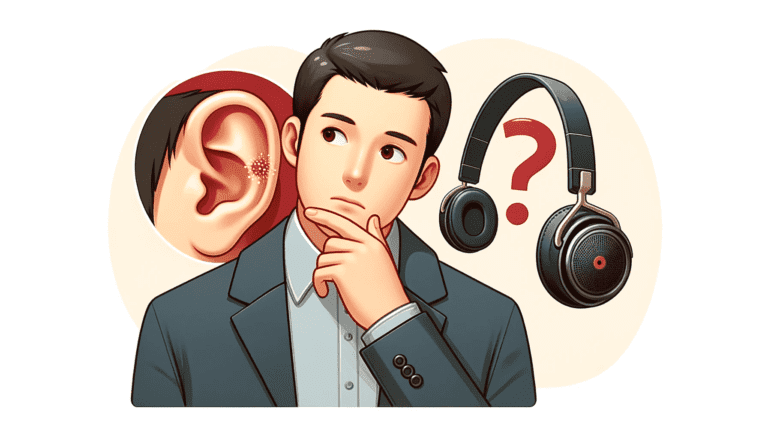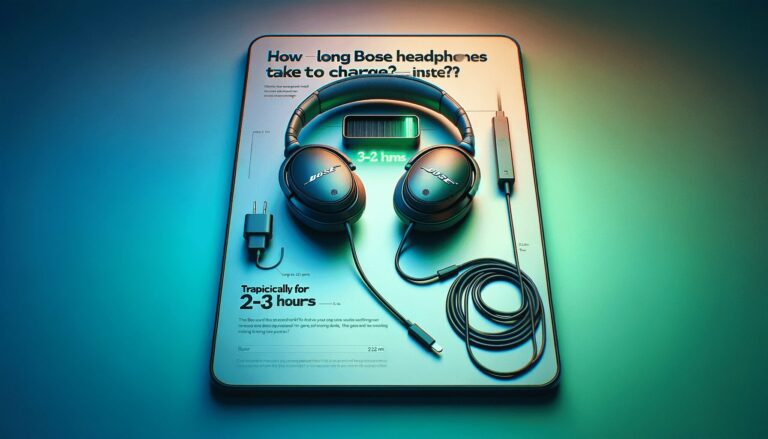How many times have you wondered if wearing headphones could change the shape of your head? It’s a common question among music lovers and professionals who spend most of their time with headphones on. So, let’s get straight to the point and find out more about this fascinating topic.
‘Can headphones change the shape of your head?’ – The simple answer to this intriguing question is: No.
Let’s be clear, headphones can cause some physical changes. But before we dive deeper into the world of sound, skulls, and science, let’s outline three of the most frequently noticed impacts.
- Temporary indentation caused by pressure
- Hair pattern disruptions due to continuous wear
- Potential for auditory damage with high-volume use over time
But, can headphones change the shape of your skull permanently? This is where scientific facts, expert opinions, and evidence all agree and say, Don’t worry, your beats won’t harm your bone structure.<!–
Unraveling the Myth: Can Headphones Reshape Your Skull?
Understanding the Human Skull
The human skull is a complex structure, designed to protect the brain and support the features of the face. Comprised of 22 bones, which are mainly connected by sutures, the skull is both durable and somewhat flexible, especially in infancy. These sutures allow for the skull’s growth during childhood but fuse in adulthood, significantly reducing the skull’s ability to change shape.
Adult skulls can withstand a considerable amount of pressure without altering shape. However, the skull is not impervious to change. Prolonged and consistent pressure in a localized area can lead to bone remodeling over prolonged periods of time, a process known as Wolf’s Law. This is more common in infants with malleable skulls and less so in adults.
- The skull is made up of 22 bones.
- Sutures are the fibrous joints connecting these bones.
- Wolf’s Law suggests bones can remodel in response to pressure.
Tip: While the adult skull is resilient, it’s important to avoid excessive pressure on any part of the head for extended periods to prevent discomfort or potential issues.
The Anatomy of Headphones and Pressure Points
Headphones, by design, exert a certain level of pressure on the head and ears to maintain a secure fit. This pressure is distributed across headphones headband applies pressure various points, primarily the top of the head and the area surrounding the ears. The materials used in the headphone headband and ear cups, such as foam padding or silicone, play a crucial role in cushioning these pressure points.
However, not all headphones are created equal when it comes to the distribution of pressure. Below is a list highlighting the common pressure points affected by headphone use:
- The crown of the head, where the headband rests
- The temporal region, particularly with on-ear headphones
- The auricular area, or around the ear, with over-ear designs
- The jawline and cheekbones, especially with heavier models
Tip: To minimize discomfort, periodically adjust the position of your headphones and take short breaks during extended use.
It’s essential to understand that while discomfort can be a temporary sensation, prolonged and consistent pressure may lead to concerns about the potential reshaping of the skull. The human skull is robust, but it is also subject to the laws of physics, including pressure-induced deformation, albeit typically over a much longer timescale than headphone use would imply.
Long-Term Use: Observations and Evidence
The debate over whether headphones can permanently alter the shape of one’s head hinges on anecdotal observations and the scarce evidence available. Long-term users of headphones, particularly those who wear them for several hours each day, have reported no significant changes in the structure of their skulls. However, some individuals claim to feel a temporary indentation after a few hours of prolonged use of heavy headphones, which typically resolves after a short period.
Comfort is a key factor in these reports, with users noting that well-padded and properly adjusted headphones minimize any temporary marks or discomfort. To illustrate the experiences of frequent headphone users, consider the following points:
- Consistent pressure in the same area can lead to temporary skin indentations.
- The human skull is rigid and not easily malleable; thus, permanent reshaping is highly unlikely.
- Any lasting changes are more often related to the skin and hair than the bone structure.
Tip: To avoid even temporary discomfort or indentations, take regular breaks and ensure your headphones fit comfortably without exerting excessive pressure.
While the notion that headphones could reshape the skull remains largely unfounded, it is essential to make loose headphones prioritize comfort and safety to prevent any potential issues related to long-term wear.
Scientific Insights: What Research Says About Headphones and Head Shape
Reviewing Past Studies
The question of whether headphones can alter the shape of one’s head has been the subject of various studies over the years. A thorough review of past research reveals a consensus that the human skull, being a rigid structure, is not easily malleable by external devices like headphones.
Key findings include:
- No significant changes in skull shape due to headphone use
- Minor temporary indentations can occur with tight-fitting headbands
- No evidence of long-term deformation
It is important to note that while the skull itself remains unaffected, prolonged pressure on outer skin can lead to discomfort or skin indentations. These effects are typically temporary and resolve once the pressure is removed.
Tip: To avoid discomfort, it is advisable to take regular breaks from headphone use and ensure that the headband is not overly tight.
Expert Opinions and Medical Advice
When it comes to the impact of headphones on the shape of the human head, medical experts head dent, and audiologists have weighed in to provide a professional perspective. They generally agree that the human skull is robust and unlikely to deform under the pressure exerted by headphones during normal use.
However, some experts caution that excessive use, or too much pressure, especially with tightly fitting models, could potentially lead to temporary indentations or discomfort. This is particularly true for children, whose skulls are still developing.
- Temporary Indentations: Can occur with prolonged, tight use
- Discomfort: May arise from pressure points
- Children: More susceptible to pressure effects
Tip: To minimize risks, experts recommend taking regular breaks and ensuring that headphones fit comfortably without excessive clamping force.
Ultimately, while the consensus is that headphones are unlikely to alter skull shape permanently, attention to usage habits and proper fit can help avoid any potential issues.
Debunking Common Misconceptions
When it comes to the belief that headphones can permanently alter the shape of one’s head, several misconceptions persist. One of the most prevalent is the idea that the pressure exerted by headphone bands can deform the skull. However, the human skull is remarkably resilient and designed to protect the brain, making it resistant to such minor forces.
Myth: Wearing headphones for an extended period will lead to hearing loss due to indentations in the skull.
Reality: The skull is not malleable like clay; it cannot be reshaped by the mere pressure of headphones.
Another common fallacy is that children’s heads are more susceptible to reshaping due to headphone use. While it’s true that younger individuals have softer bones, the growth and development of the skull are guided by genetic and biological factors, not by external objects like headphones.
Tip: Always ensure that your headphones fit comfortably without exerting excessive pressure, as comfort is key to preventing any temporary marks or discomfort.
In summary, while headphones can cause temporary indentations on the skin or hair, they cannot change the structure of the skull. It’s important to choose well-designed headphones and to use them responsibly to avoid any discomfort.
Personal Accounts and Anecdotal Evidence
Stories from the Headphone Community
The headphone community is rife with personal anecdotes about the long-term use of headphones and their effects on the head’s shape. Some users report a noticeable indentation at the top of their heads after years of wearing tight, over-ear headphones, while others claim no visible change.
- User A: “After 5 years of daily use, I can feel a slight dip where the headband sits.”
- User B: “I’ve used headphones for a decade, and my head is just as round as it was before.”
- User C: “I switched to in-ear monitors because I was worried about the pressure on my skull.”
These accounts vary widely, and without scientific measurement, it’s difficult to ascertain the verity of each claim. However, they do highlight the diversity of experiences within the community.
Tip: If you’re concerned about the pressure from headphones, consider alternating between different types and taking regular breaks to alleviate any potential stress on your head.
Comparing Before and After Images
The visual comparison of before and after images serves as a compelling form of anecdotal evidence for many headphone users. These images often circulate within online communities, sparking discussions about the potential long-term effects of headphone use on head shape. However, it’s crucial to approach such evidence with a critical eye, as photographic conditions, angles, and lighting can all influence the perceived outcome.
To objectively assess these images, one might consider the following criteria:
- Consistency of the photographic conditions
- The duration of headphone use between images
- Any noticeable changes in head shape or symmetry
Remember, while before and after images can be intriguing, they should not be taken as conclusive evidence without supporting scientific research.
It’s also important to note that any changes are likely to be subtle and may not be easily discernible to the untrained eye. Personal accounts should be supplemented with professional opinions when considering the impact of headphones on head shape.
Psychological Effects of Head Shape Concerns
The fear of permanently altering one’s head shape due to prolonged headphone use can have significant psychological effects. For some, this concern inner ear part goes beyond vanity and taps into deep-seated anxieties about physical appearance and self-perception. The worry that headphones could deform the skull, even though unfounded, may lead to a reluctance to use them, impacting daily routines and enjoyment of music or media.
- Concerns about head shape can lead to anxiety and self-consciousness.
- Some individuals may avoid using headphones altogether.
- The fear can affect daily life and leisure activities.
Tip: It’s important to remember that while comfort is key, the likelihood of headphones reshaping your skull is extremely low. Choosing well-fitted headphones and taking regular breaks can alleviate both physical discomfort and psychological worries.
The Role of Headphone Design in Comfort and Safety
Ergonomics of Headphone Wear
The ergonomics of headphone wear is a crucial aspect that impacts both comfort and the potential for altering head shape. Manufacturers design headphones with various headband tensions and cushioning materials to distribute pressure evenly across the head. However, the individual shape and size of a user’s head can significantly influence how this pressure is felt.
Comfort is paramount when selecting headphones, as a well-fitted pair reduces the risk of excessive pressure that could lead to discomfort or even headaches. Here are some ergonomic features to consider:
- Adjustable headbands to fit different head sizes
- Memory foam or soft leather ear cushions for comfort
- Swivel ear cups to accommodate different ear positions
Tip: Always ensure that your headphones have an adjustable headband and ample cushioning to minimize pressure points and enhance comfort during extended use.
Innovations in Headphone Technology
The landscape of headphone technology has seen remarkable changes aimed at addressing comfort and mitigating any potential for altering head shape. Ergonomics have taken center stage, with manufacturers introducing designs that distribute pressure more evenly across the head. For instance, adjustable headbands and memory foam ear cushions are now commonplace, providing a custom fit that adapts to the user’s unique head contour.
Recent advancements have also focused on reducing the overall weight of headphones, utilizing lightweight materials that lessen the burden on the wearer’s head and neck. Wireless technology has further revolutionized the headphone experience by eliminating the constraints of cables, thereby reducing the tug and pull on the ears and head.
- Adjustable headbands for a better fit
- Memory foam ear cushions for comfort
- Use of lightweight materials
- Integration of wireless technology
Tip: To ensure maximum comfort and safety, regularly adjust your headphones to avoid prolonged pressure on any one area of the head.
Choosing the Right Headphones for Your Head
Selecting the right headphones is crucial not only for audio quality but also for the comfort and health of your head. When shopping for headphones, consider the following points to ensure a good fit:
- Headband adjustability: Look for headphones with a flexible and adjustable headband that can comfortably accommodate the size and shape of your head.
- Ear cup size and shape: Ensure the ear cups are the right size to cover your ears without applying excessive pressure.
- Padding and materials: Check for ample and soft padding that can reduce the risk of discomfort during prolonged use.
Tip: Always try on headphones before purchasing to assess the fit and comfort on your own head.
Remember, the goal is to find headphones that provide a balance between sound quality and ergonomic design. Poorly fitting headphones can lead to discomfort and even pain, so it’s worth investing time to find the perfect pair for your unique head shape.
Preventive Measures and Best Practices
Recommended Usage Times
When it comes to using headphones, moderation is key. Health experts often suggest limiting continuous headphone use to prevent potential negative effects on the ears and the pressure exerted on the head. Below is a guideline for recommended usage times:
- Children (under 18 years): No more than 1 hour per day
- Adults: Up to 2 hours of continuous use, with breaks
It’s important to note that these are general recommendations and individual tolerance may vary. Taking regular breaks can help minimize the risk of discomfort and the unlikely event of head shape changes.
Tip: To reduce the risk of hearing damage and discomfort, consider using headphones at no more than 60% of their maximum volume.
Incorporating breaks into your listening routine not only helps in maintaining the natural ear shape because of the dent in your head but also in preserving your hearing health. If you experience any discomfort or pain, it’s advisable to reduce usage time and consult a healthcare professional.
Exercises to Counteract Pressure
Consistent use of headphones can lead to discomfort due to pressure on certain areas of the head. To alleviate this, engaging in specific exercises can be beneficial. These exercises aim to reduce tension and promote blood circulation, which may help in mitigating any potential reshaping effects of prolonged headphone use.
- Neck rotations: Gently rotate your neck in a circular motion to loosen the muscles around the cervical spine.
- Scalp massages: Use your fingertips to massage your scalp in circular motions, which can help in relieving pressure points.
- Jaw exercises: Open and close your mouth slowly to stretch the jaw muscles, which can also be affected by headphone bands.
Tip: It’s important to perform these exercises gently and without applying excessive force to avoid any additional strain.
Incorporating a few tips these simple exercises into your daily routine can serve as a preventive measure against the prolonged pressure exerted by headphones. Remember to take regular breaks during headphone use to give your head and ears a rest.
When to Seek Medical Advice
While headphones are generally safe, there are times when it’s prudent to consult a medical professional. If you experience persistent discomfort, pain, or any noticeable changes in the shape of your head or ears, it’s important to seek medical advice. Persistent symptoms should not be ignored as they could indicate underlying issues or underlying medical condition that extend beyond the superficial effects of headphone use.
- Listen to your body’s signals and consider the following scenarios where a doctor’s visit is advisable:
- Persistent pain or discomfort after headphone use
- Visible deformity or change in head shape
- Symptoms of skin irritation or allergic reactions
- Signs of hearing impairment or tinnitus
Tip: Early consultation can prevent minor issues from developing into more serious conditions. It’s better to be cautious and get a professional opinion if you have any concerns.
Remember, the goal is to enjoy your audio experience without compromising your health. Regular breaks, proper fitting, and awareness of usage limits can help minimize risks. However, if problems persist, don’t hesitate to contact a healthcare provider.
Conclusion: Separating Facts from Fiction
In the quest to discern myth from reality, it’s clear that headphones, under normal use, are unlikely to alter the shape of one’s head permanently. While they may cause temporary indentations or discomfort, these effects are typically short-lived and resolve once the pressure is removed.
Users need to prioritize comfort and proper fit to minimize any potential for temporary deformation. Ultimately, the fear that headphones could reshape our skulls seems to be more fiction than fact, allowing music lovers and audiophiles to breathe a sigh of relief.
Frequently Asked Questions
Can wearing headphones change the shape of my head?
There is no scientific evidence to suggest that headphones can permanently alter the shape of your skull as it is made of bone, which is rigid and hard to reshape without significant force.
Is it possible for headphones to cause temporary indentations on the head?
Yes, wearing headphones for extended periods can cause temporary indentations or red marks on the skin due to pressure, but these typically resolve once the pressure of tight headphones is removed.
How long would I have to wear headphones for them to affect my head shape?
Headphones are not capable of changing the shape of dent your head or skull, regardless of how long you wear them. However, long-term use without breaks can cause discomfort and pressure points on the skin.
What can I do to prevent discomfort when using headphones for a long time?
To prevent discomfort, choose well-padded headphones that fit properly, take regular breaks, and adjust the headband to reduce pressure.
Are children more susceptible to having their head shape altered by headphones?
Children’s skulls are more malleable than adults, but there is still no evidence that headphones can alter the shape of a child’s head. It’s important to wear headphones correctly ensure a proper fit and limit usage time for comfort.
What are the signs that my headphones are too tight and could be causing problems?
Signs that your headphones might be too tight include headaches, soreness around the ears or scalp, and visible marks or indentations on the ear lobes or the head after use. If you experience these, consider adjusting the fit too loose headphones or taking breaks more frequently.
Do headphone dent go away?
Yes, headphone dents often go away over time. The skin and hair on your head can recover from the temporary indentations caused by wearing headphones. To speed up the process, you can gently massage the area to improve blood circulation and avoid wearing headphones for extended periods.






